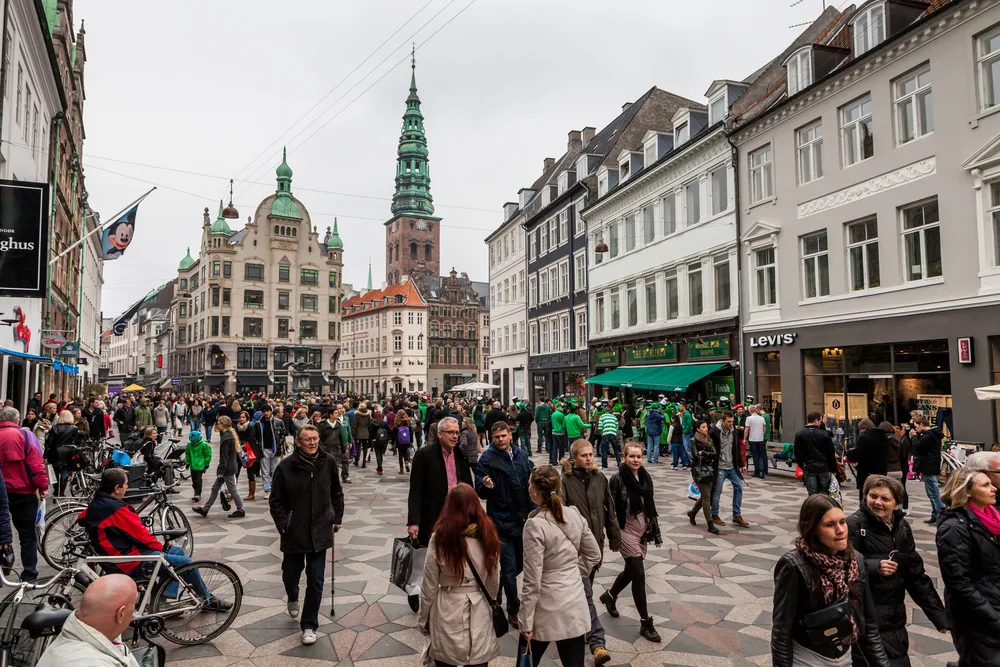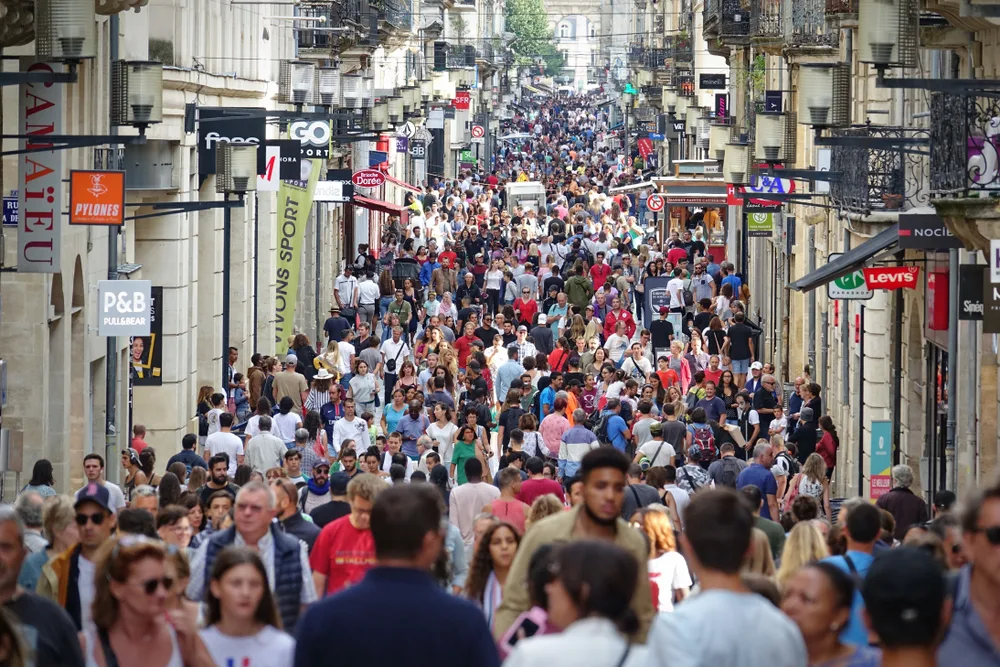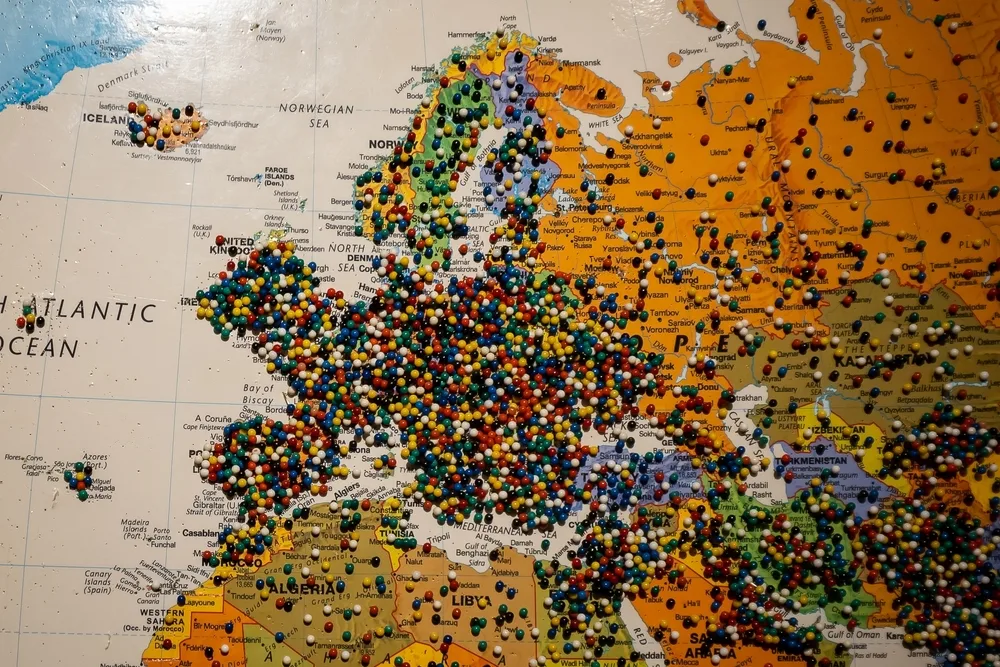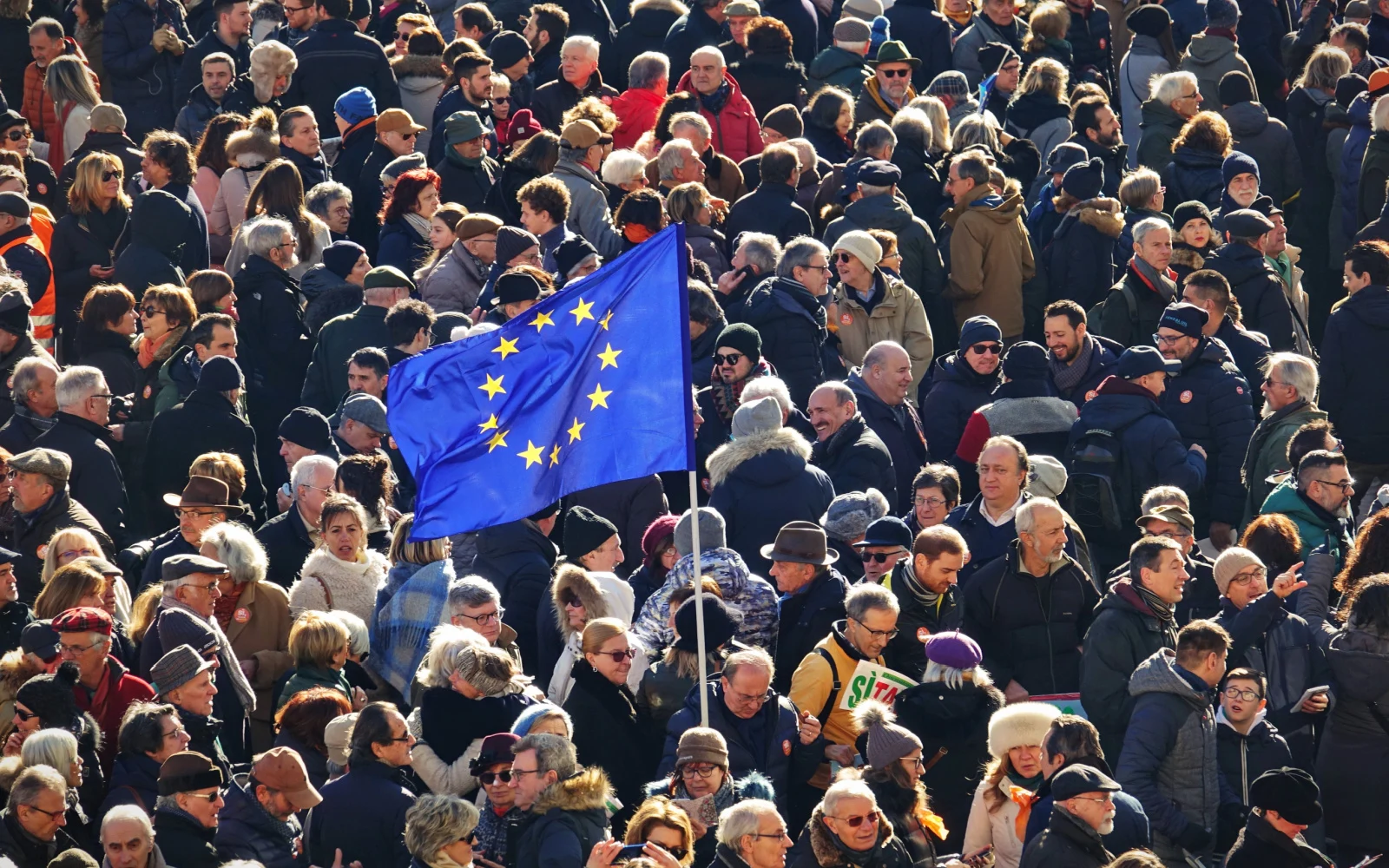Though it is small for a continent, Europe holds a mighty place in the world’s imagination. It is a vibrant center of culture and cuisine, ranking consistently as the most popular travel destination.
Much of its vibrancy stems from the vast number of people and traditions crammed into such a small area. This leads many folks to wonder: just how many people are there in Europe, anyway?
Perhaps you’re an armchair traveler simply curious about the state of the world. Maybe you’re a student looking for good intel on Europe, or perhaps you’re a tourist trying to plan their next trip and soaking up all the information you can.
Whatever the case, we’re here to help! In today’s post, we’ll discuss Europe’s population as a whole, its most populous countries and cities, and some other facts and figures for your perusal.
So grab a Turkish coffee, Bavarian lager, Italian soda, or Spanish sangria, and keep reading.
Population of Europe

COPENHAGEN, DENMARK – MARCH 17: Amagertorv square at the city centre in Copenhagen on March 17, 2012. Copenhagen is the capital and most populated city of Denmark./Oscity/Shutterstock
The current population of Europe is more than 742 million, according to the most recent estimates.
While there exists debate about which nations fall into which quadrants of Europe, the population can be divided up into regions like so:
- 288 million in Eastern Europe
- 196 million in Western Europe
- 151 million in Southern Europe
- 107 million in Northern Europe
Moreover, the “Europe population is equivalent to 9.32% of the total world population” and “The population density in Europe is 34 per [square kilometer],” which translates roughly to about 87 people per square mile.
This is only an average density, however. There are marked differences in population densities in rural and urban areas, which we will discuss in a moment.
Population of the European Union
Many readers might wonder whether the above figures are applicable to the population of the European Union (EU), and the answer is no.
The EU is a collection of 27 countries bound by political and economic ties, representing roughly half of Europe’s total 50 countries.
For that reason, their population numbers are significantly lower than that of Europe as a whole. According to the most recently available figures from the EU, its population hovers around 448 million.
That’s nearly 300 million less than Europe as a whole. And where exactly are these people located, you’re wondering?
The Urban-Rural Breakdown in Europe
“In 2021, some 38.9 % of the EU population was living in a city, with lower shares living in towns and suburbs (35.9 %) and in rural areas (25.2 %),” says the EU. These are, once again, the most recently available figures.
In Europe, the numbers are similar, though urban and suburban populations have been combined.
According to The Global Economy, “The [rural] average for 2022 based on 47 countries was 27.12 percent. The highest value was in Liechtenstein [at] 85.46 percent and the lowest value was in Gibraltar [at] 0 percent.” That makes sense, since Gibraltar is a British territorial city located on the Iberian peninsula of 2.6 square miles total, so all of its inhabitants are urban.
In essence, though, the numbers are similar, with rural figures hitting roughly 25% in the EU and 27 in Europe as a whole.
Recent Population Changes in Europe

BORDEAUX, FRANCE – august 2018: People walking in Rue Sainte Catherine, the main shopping street in Bordeaux./MikeDotta/Shutterstock
During the recent pandemic, the population of Europe took a dip. However, it has shown significant recovery over the last several years.
According to Eurostat, “After a decline in population in 2020 and 2021 due to the impact of the COVID-19 pandemic, the EU’s population increased in 2022, from 446.7 million on 1 January 2022 to 448.4 million people on 1 January 2023. The negative natural change (more deaths than births) was outnumbered by the positive net migration.”
As for the growth, “The observed population growth can be largely attributed to the increased migratory movements post-COVID-19 and to the mass influx of displaced persons from Ukraine who received temporary protection status in EU countries, as a consequence of the Russian invasion in February 2022.”
Keep in mind that these numbers stem only from the EU, so they are lower than the overall European population figures. There are slight differences between the two.
For instance, Europe saw a slight growth during 2020. While it was only .04 percent, it was not the decline reported by the EU. Still, the population growth holds across the continent.
Largest Countries in Europe by Population
Europe is a fascinating country with tons of differences among its populations, even in a very small amount of space. We need look no further than the above figures that put Lichtenstein’s rural population at more than 85% to see that people really do it differently across the continent.
But where are the most people located, you’re wondering? Here’s a quick look at the current breakdown.
1. Russia
Russia has in the past been one of the most popular tourist destinations, though travelers are currently watching it carefully for safety reasons.
One of the reasons it was so popular to visit – and may be again – is that there’s much to see because of its huge size. How huge? Believe it or not, Russia is about 1.7 times bigger than Europe.
You read that right: the continent is smaller than the country. According to My Life Elsewhere, “Europe is approximately 10,180,000 sq km, while Russia is approximately 17,098,242 sq km, making Russia 68% larger than Europe.”
As compared to the US, Russia is about twice as big. It’s no surprise, then, that it’s population clocks in as the highest by far, at more than 144 million people.
It’s important to note, however, that Russia is only provisionally part of Europe. Its landmass west of the Ural Mountains lies on the European continent, while the rest of it – the vast majority – lies in Asia.
2. Germany
Germany is the second-largest country by population, with about 83 million inhabitants. Why is it so populous even though France, Spain, Sweden, and the Ukraine are larger by territory?
Probably because, as the German Federal Government explains, “Germany is known for being a good place to live and work in and therefore is more attractive for immigrants than ever. Since 1950 there have only been a few years in which more people emigrated from than immigrated to Germany.”
3. The United Kingdom
Next up: Great Britain, with about 68 million people. Like Germany, the UK is not at the top of landmass sizes but still stacks up when it comes to population density. This is also due largely to social factors, The Guardian says:
“The population boom elsewhere in Britain started in the mid-90s. There were international factors: the end of the cold war, a more interwoven global economy and the expansion of the EU. British universities sought more foreign students, and Mediterranean countries began to struggle economically.”
With immigrants having more children than existing Britons, social pressures also encouraged an upward trend.
Other places in Britain, such as Liverpool and Glasgow, have seen dramatic population downturns, however. This makes them calm, cozy places for the tourist. What about the rest of the top 10?
They include, rounded to the nearest million:
- France at 65 million
- Italy at 59 million
- Spain at 47 million
- Poland at 41 million
- Ukraine at 37 million
- Romania at 20 million
- The Netherlands at 18 million
Largest Cities in Europe by Population

Paris, France – 2022: Map of Europe with pins. Selective focus. Many multi color pins clustered in Western Europe./EWY Media/Shutterstock
The largest cities in Europe by population are:
- Moscow, Russia
- London, UK
- Saint Petersburg, Russia
- Berlin, Germany
- Madrid, Spain
- Kyiv, Ukraine
- Rome, Italy
- Paris, France
- Bucharest, Romania
- Minsk, Belarus
Frequently Asked Questions

London, UK – August 24, 2016: Lots of people crossing the Regent street at the traffic lights. Populated city concept/IR Stone/Shutterstock
Here are some more frequently asked questions about Europe’s population.
How many countries are there in Europe?
Population discussions are often troubled by the fact that no one can quite decide how many countries there are in Europe. Some sources say 50 but include disputed areas, such as Greenland or Kosovo.
Others say only 44, leaving these areas out. Still others say 45, so it’s hard to tell. As such, population figures vary as well. We simply do our best to rely on the most reputable sources and provide good averages.
Do more people live in the city or the country?
This question is definitely easier to answer, since the answer is a resounding “city”! The breakdown between suburban and true urban areas varies from place to place and depending on what definition you use, but it’s still a pretty stark split.
Is the population increasing or decreasing?
The population of Europe appears to be increasing overall. While Europeans tend to have fewer children than migrants from other continents, that very migration is causing an overall increase in the number of people where otherwise deaths might outweigh births.
However, other sources point out that “Europe is expected to lose roughly thirty million people of working age by 2050,” despite figures growing overall.
Is the population of Europe the same as the population of the EU?
No, the population of Europe and the EU are different. This is for the very simple reason that the EU only includes about half of the total countries of Europe. You can see a full list of member countries here.
To Europe … and Beyond
Knowing the population of Europe is useful to the traveler who is looking for a particular experience. For those who love the urban scene, densely packed countries such as Germany or the UK are best.
Those who want a more laid-back rural vibe are better off seeking out the areas of lowest population density.
So that’s it! Whether you are a tourist, student, or armchair traveler, we hope this has answered your questions about the population of Europe … and inspired you to plan a trip today!



